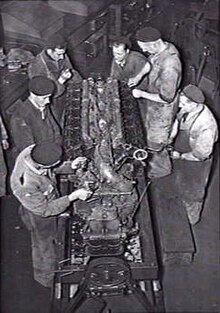No. 1 Aircraft Depot RAAF
As well as servicing aircraft and other equipment, in its early years the depot supported survey flights in Australia and the Pacific region.
1 AD's strength increased from 350 staff in the 1930s to over 2,000 during World War II, when it assembled, tested and repaired aircraft ranging from Tiger Moth trainers to Spitfire fighters to B-17 Flying Fortress heavy bombers.
[3] Prior to this it comprised two elements in Melbourne, one at Spotswood handling the equipment of the Imperial Gift (128 surplus aircraft and associated spare parts donated by Great Britain following World War I), and another at Fitzroy North responsible for motor vehicle repair.
1 AD was officially established at RAAF Point Cook, Victoria, on 1 July, the Spotswood component was dissolved, while North Fitzroy continued to operate as a detachment.
The unit's inaugural commanding officer was Squadron Leader Bill Anderson, who was also in overall charge of Point Cook.
[5][6] In September 1921, the government had purchased land at Laverton, near a railway station eight kilometres (five miles) inland from Point Cook, for the express purpose of constructing a dedicated home for No.
[1] In July 1927, it was the departure point for the Northern Survey Flight, comprising a de Havilland DH.50 and two Airco DH.9s, which reconnoitred air routes and landing grounds in northern and central Australia under the command of the Chief of the Air Staff, Wing Commander Richard Williams.
[1] The NA-16 was later augmented by the purchase of the more advanced North American NA-33, which was licensed and built in Australia by the Commonwealth Aircraft Corporation as the CAC Wirraway.
[12] To cope with the Government's decision to rapidly expand the RAAF, a Recruit Training Section, incorporating the nascent School of Armaments and Signals, was formed under the depot's auspices by Flight Lieutenant Charles Eaton on 1 March 1935; it was reorganised as Recruit Training Squadron on 1 September 1936.
1 AD also commenced formal training courses for aircraft fitters and riggers in 1935, leading to the formation of No.
1 AD's workshops, under the command of Squadron Leader Arthur Murphy, specially modified a Wapiti and a de Havilland Gipsy Moth for Antarctic conditions, to enable an Air Force team led by Flight Lieutenant (later Group Captain) Eric Douglas and Flying Officer Alister Murdoch to rescue explorer Lincoln Ellsworth, who was presumed lost on a journey across the continent.
[14][18] Coupled with its aircraft assembly and test facilities, the recruit training unit made Laverton an obvious choice for the establishment of future RAAF squadrons.
[1] Although many squadrons were raised at RAAF Station Laverton during World War II, the base's prime focus continued to be its aircraft depot.
1 AD began expanding to handle the RAAF's growing number of training and combat aircraft, among them the Wirraway, de Havilland Tiger Moth, Lockheed Hudson, Hawker Hurricane, and Curtiss P-40 Kittyhawk.
The depot assembled and tested new aircraft, and ferried them to operational areas such as northern Australia and New Guinea.
1 AD came under the auspices of Southern Area Command, which was headquartered in Melbourne and was responsible for RAAF units located in Victoria, South Australia and Tasmania.
1 AD undertook research and development on aircraft such as the Supermarine Spitfire, CAC Boomerang, and Wackett Woomera.
It also ran comparative performance studies on Spitfires, Boomerangs, Kittyhawks, Brewster Buffalos, and Mitsubishi Zeros.
[26] Fighter aces Alan Rawlinson and Wilfred Arthur, along with a United States Army Air Forces pilot, conducted comparative trials between a Boomerang, a Kittyhawk, a Buffalo, and a Bell Airacobra.
[27] The depot began despatching the Boomerangs to their operational units in March 1943, and the following month performance-tested a turbocharged version of the CA-14, though this model never entered production.
1 AD also completed fitting out a Douglas Dakota with an office, a lounge suite, and a kitchenette for service as the Governor-General's VIP transport, operated out of Laverton by No.
[32][33] In 1950, the depot received the sole high-performance piston-engined CAC CA-15 to be built, which had been sent to be "converted to components" (scrapped).
1 Long Range Flight prior to the unit taking part in the 1953 London-to-Christchurch air race.
1 AD maintained a detachment at RAAF Station Tocumwal, New South Wales, to store obsolete aircraft awaiting disposal.
[1][43] By September the following year the depot's strength was down to 235 staff, but it pioneered the support of new technologies for the Air Force in such fields as electroplating, fibre optics, and electronics.


